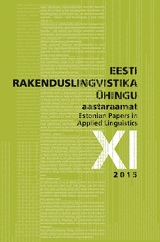Kui lapsega ei räägi üksnes ema:
When the mother is not the only one talking to a child:
Selection of terms in Estonian child language and caregivers’ speech
Author(s): Helen Kõrgesaar, Airi KapanenSubject(s): Language and Literature Studies, Language acquisition, Sociolinguistics, Finno-Ugrian studies
Published by: Eesti Rakenduslingvistika Ühing (ERÜ)
Keywords: first language acquisition; child-directed speech; fatherese; motherese; lexicon of terms; Estonian
Summary/Abstract: The article focuses on specifying and describing the terms used in Estonian child language and child-directed speech. The terms used now do not offer enough necessary and precise tools for researchers of child language. Since children of different ages and proximities are talked to differently, a need has arisen to define the different types of child-directed speech, due to the multiple interpretations of terms and their concepts. Although most of the terms describing speech directed from an adult to a child have been considered synonyms in the English linguistics literature, this might not be the case in Estonian scientific language. The confusion of terms in English science is due to the massive amount of researchers and publishers which obviously makes it difficult to achieve uniformity. Taking into consideration this multitude of terms and confusion of concepts, the authors of this article offer recommended terms to be used in the future research of child and child-directed speech, in order to simplify the research and facilitate understanding of the terminology. The circle of researchers of child and child-directed speech in Estonia is quite narrow, which not only makes the implementation of clear, specified terms easy to agree on but would also greatly benefit the field of research itself. The authors are aware that in English scientific literature the terms used (e.g. motherese, fatherese, parentese) are not strictly distinctive, often due to the fact that it is not necessary, if the aim is to research child-directed speech in general. Since Estonian child language research is diversified, the necessary tools in the form of Estonian-language terms should be provided to be used according to the aim of the researcher.
Journal: Eesti Rakenduslingvistika Ühingu aastaraamat
- Issue Year: 2015
- Issue No: 11
- Page Range: 177-188
- Page Count: 12
- Language: Estonian

